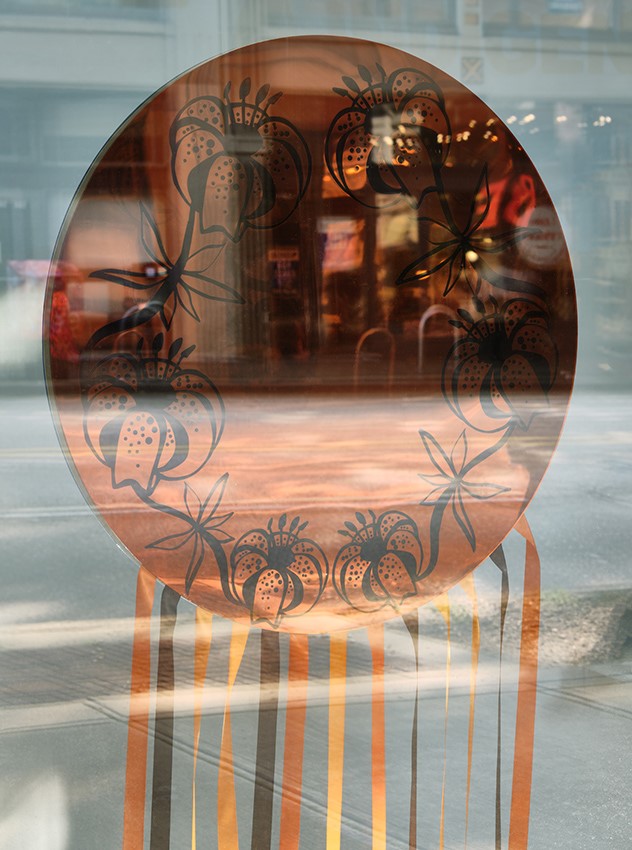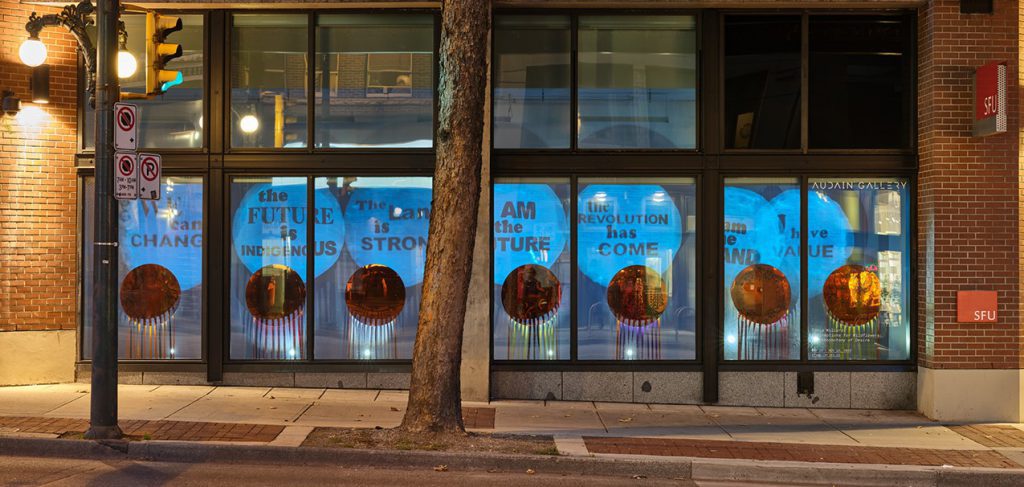Affirmations for Wildflowers: An Ethnobotany of Desire: Tania Willard at SFU Audain Gallery
12 November 2021
By Andrea Valentine-Lewis
WE can CHANGE
the FUTURE is INDIGENOUS
the Land is STRONG
I AM the FUTURE
the REVOLUTION has COME
I am the LAND
I have VALUE
Tania Willard’s Affirmations for Wildflowers: An Ethnobotany of Desire, ran from September 14th to November 13th, 2020, within the street-facing windows of the SFU Audain Gallery. The seven statements including “the Land is STRONG” and “I have VALUE” were projected as glowing declarations onto a wall running the length of the windows. Each declaration, or “affirmation” as the exhibition’s title suggests, was accompanied by suspended copper-coloured reflective disks, the surface of which were etched with black wildflower silhouettes. At the bottom of each disk, a trim of pink, orange, yellow, and brown silk ribbons embellished the composition.
According to the exhibition’s text, the various wildflowers etched across the surface of the copper disks bloomed in abundance during the late spring and early summer of 2020 in Willard’s home territory of Secwepecúlecw—colonially known as Chase, British Columbia. While I did not immediately recognize the species of flowers from the etchings, the described tour1 distinguished them as arnica, wild rose, lupin, brown-eyed susan, yarrow, Indian paintbrush, and lily.
Given its visually prominent placement in the street-facing windows of the gallery, Willard’s project could be considered an extension of the street. The composition illuminates the juxtaposition between the wildflowers and the urban environment—suggesting wildness and domestication, drawing us to consider the future of land and what it means to occupy it. The copper medallions act as mirrors, allowing us to view ourselves in tandem with the plants, the street (West Hastings), and its various landmarks, which include a furniture store, a yoga studio, a supplement shop, and a short-term loan service company. As we embody this reflective state, considering ourselves in addition to the space we occupy, Willard’s phrases become both socio-political and interpersonal, revealing that they can be regarded both as statements and as questions to ask ourselves.
In the online talk, it was noted that Willard’s window project changed as the day turns to night: during daylight hours, the surface of the orange circles was more reflective than during the night, whereas in the evening when the street was illuminated only by the glow from fluorescent signage, Willard’s projected affirmations appeared as bright orbs, interjected with black block text.2 The bright orbs were reminiscent of X-ray scans—semi-translucent and rippled on the edges, with text in place of what would be brain activity. The luminosity of the project’s nighttime presentation was accompanied by another source of light—the copper disks were lit from the rear by flashlights. Because the disks blocked the light, the coloured silk ribbons were the only element that assumed the spotlight.

When I walked the length of the gallery’s windows at night, I was periodically blinded by the lights from either the projection or the disk’s flashlight. I welcomed that feeling of agitation in the end, because as a white settler, I recognize the need to be confronted by the messages Willard’s project brought forth especially on West Hastings Street, a particularly gentrified part of the Downtown Eastside.3 In fact, the Audain Gallery resides on land that has undergone significant shifts in the last century. After the bankruptcy of Woodward’s Department Store which occupied this location from 1903-1993, the building and surrounding block became a home for people without housing until 2006 when the building was demolished and eventually became what it is today: condominiums, the home to Simon Fraser University’s School for Contemporary Arts, and a variety of fancy shops and restaurants.4 It is my understanding, then, that Willard’s composition—the glowing declarations, the etched wildflowers, and the reflective materials—is a mode through which to envision the future and, in turn, a methodology of renewal.
After attending Willard’s corresponding workshop Site/ations held on October 14th through Zoom, I further understood why her installation included etchings of wildflowers. Participants were tasked with gathering various plant clippings from our backyards or around our homes, and asked to describe the significance of these plants to the rest of the group, revealing often personal and familial anecdotes and histories. Willard affirmed that each flower, bloom, leaf, or stem in itself contains vital information. She said birch bark and cedar root, for example, can teach us how to weave baskets through its materiality; she specified that this information can be found by observing the direction the fibers are situated along the trunk and how they naturally bend and flex. Through the workshop, Willard demonstrated how we can author our own citations through our personal associations with plants. This alternative to the limiting structure of the academic citation reveals prosperity and futurity in plants and life beyond the institution.
The most captivating element of this commanding composition is the ability to see oneself in addition to the urban and gentrified landscape within the etched and mirrored surface of the seven copper medallions. It is as if Willard’s work is demanding accountability: your own personal and individual accountability. When we face ourselves and Willard’s bold and illuminated phrases, we are either validated or repudiated about how we navigate ourselves in relation to the natural landscape. Affirmations for Wildflowers: An Ethnobotany of Desire challenges us to look at wildflowers—and our natural environment—as the only future-oriented solution to heal our present.
- Stephanie Bokenfohr, Affirmations for Wildflowers: An Ethnobotany of Desire, music and sound by Gabi Dao (2020; Vancouver: SFU Galleries, 2020), described audio tour recording, 23:31.
- “Workshop: Site/ations with Tania Willard,” (SFU Galleries, Zoom, October 14, 2020).
- It is essential to note that West Hastings (and particularly the block where the Audain Gallery is) has been a prominent focus for Stan Douglas. Douglas’s 2002 publication, Every Building on 100 West Hastings was based on his large-scale panorama capturing the street; the book, a compilation of critical essays, examines this historically vibrant block within the Downtown Eastside.
- Stan Douglas’s large-scale lightbox image Abbott & Cordova, 7 August 1971 from 2008 currently looms over the courtyard of the renovated Woodward’s complex. The image presents a reenactment of the violent riots that took place between the Vancouver police and a large group of peaceful protesters, namely those taking up residence in the then-abandoned Woodward’s Department Store.
Affirmations for Wildflowers: An Ethnobotany of Desire ran from September 14th to November 13th, 2020, at SFU Audain Gallery in Vancouver, BC.
Feature Image: Installation view of Affirmations for Wildflowers: An Ethnobotany of Desire, 2020, by Tania Willard. Photo by Rachel Topham Photography, courtesy of the gallery.



